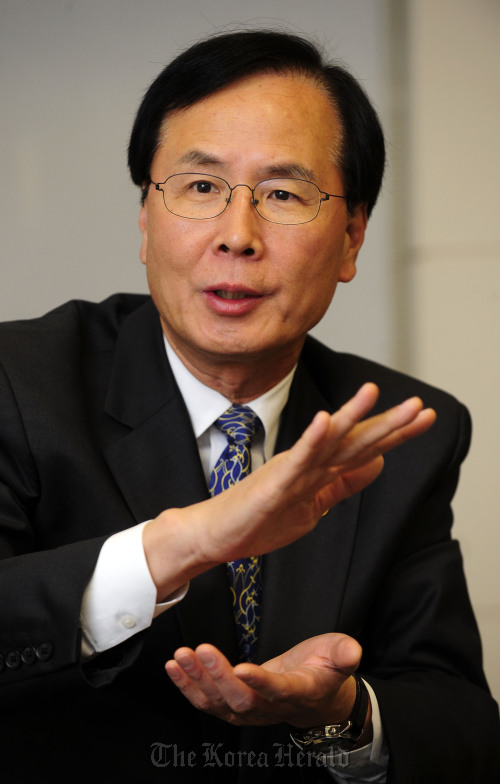DAPA to have open bidding process for surveillance drones
The chief of the state weapons acquisition agency said that how many South Korean parts will be used and technology transfers are crucial factors in determining the winner of Seoul’s project to secure next-generation fighter jets.
Defense Acquisition Program Administration Commissioner Noh Dae-lae also said Thursday that stealth is not a “prerequisite,” but part of the grading criteria, stressing that the project will proceed through an “open and fair” competition.
Concerning the efforts to procure unmanned surveillance planes, Noh has told Washington that Seoul cannot purchase Global Hawk planes for the “exorbitant prices” it offered. He said that an open bidding process will be carried out to allow many others to join the competition.
“How many South Korean parts are used in the fighter jets is a very important grading criterion. It is not just simply to sell the parts, but to learn techniques to integrate them well into the aircraft through a joint work. That is our goal,” Noh told The Korea Herald.
 |
Noh Dae-lae |
“In fact, firms such as Boeing, EADS and Lockheed Martin plan to conduct their surveys on what South Korean products can be used to produce their combat planes.”
Referring to the KF-X project aimed at developing homegrown combat aircraft, Noh pointed out that what kind of technology the competitors can offer is also part of what Seoul looks for in the FX-III acquisition program.
“The FX-III project could be a path on the way toward the KF-X project… Technologies we need are what we have yet to acquire for the KF-X project. We have already explained what we need from foreign fighter makers,” he said.
The technologies Seoul wants concern stealth technology, fly-by-wire system design, composite structure design and electronic warfare suit design, DAPA officials explained.
In the acquisition project worth around 8.29 trillion won ($7.35 billion), Seoul is seeking to purchase some 60 high-end stealth fighters to be delivered for operational deployment starting in 2016.
Lockheed Martin’s F-35 Lightning II, Boeing’s F-15 Silent Eagle and the Eurofighter Typhoon made by European Aeronautic Defense and Space Company N.V. are being cited as the likely candidates for the high-profile project.
Seoul initially focused on radar-evading functions for the new fighter fleet, viewing the stealth capability as a prerequisite. But it now regards stealth as part of the grading criteria as it inordinately limits Seoul’s choices.
“Views on stealth are varied depending on experts. Some argue with too much focus on stealth, it would limit the amount of weapons carried on a fighter. Pointing to guided surface-to-air missiles, others say stealth is important. Some also say a new radar system in the future could detect what we now call stealth aircraft,” Noh said.
“Factoring in all these, we will choose what is optimal within the limits of our budget.”
Since he took the helm of the agency in March, the 55-year-old career bureaucrat has focused particularly on “transparent and fair” competition in the country’s military acquisition programs.
“There is no other way to protect national interests than open competition. I believe we should pursue a competitive system when exports (of our defense products) increase,” Noh said.
“We need to forge an environment that allows all firms around the world with products that suit our needs to participate in Korea’s procurement projects.”
This is part of the reason why Noh has decided to carry out a competitive bidding process for the project to purchase surveillance drones.
“I said (to the U.S.) that if the price is that high (for Global Hawk planes), the value of the intelligence that can be gathered by it will not be worth (the price). We will open a bidding process,” he said.
“There are many other planes such as (AeroVironment’s) Global Observer. It is better in some parts. There is also (Boeing’s) Phantom Eye. If we carry out the acquisition project in a competitive manner, lower prices are possible.”
Seoul has sought to deploy four Global Hawk aircraft by 2015 with a budget of 450 billion won ($398.9 million). But the asking price jumped due to decreased demand for the plane caused by the reduced U.S. defense budget.
The Seoul government believes the high-altitude, long-endurance aircraft is crucial in keeping tabs on North Korean movement, particularly after it takes wartime operational control from Washington in December 2015.
Noh also dismissed speculation that the FX-III project will be delayed for the next administration to handle it, saying that it would proceed as scheduled as it is crucial for national security. He also said that the 60 fighter jets to be purchased will be the same type to ensure interoperability among them.
By Song Sang-ho and Choi He-suk
(
sshluck@heraldcorp.com), (cheesuk@heraldcorp.com)





![[Herald Interview] 'Trump will use tariffs as first line of defense for American manufacturing'](http://res.heraldm.com/phpwas/restmb_idxmake.php?idx=644&simg=/content/image/2024/11/26/20241126050017_0.jpg)

![[Health and care] Getting cancer young: Why cancer isn’t just an older person’s battle](http://res.heraldm.com/phpwas/restmb_idxmake.php?idx=644&simg=/content/image/2024/11/26/20241126050043_0.jpg)
